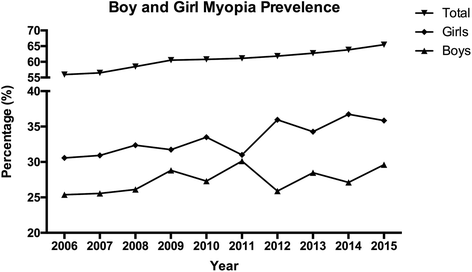The increasing prevalence of myopia in junior high school students in the Haidian District of Beijing, China: a 10-year population-based survey
- PMID: 28606071
- PMCID: PMC5468969
- DOI: 10.1186/s12886-017-0483-6
The increasing prevalence of myopia in junior high school students in the Haidian District of Beijing, China: a 10-year population-based survey
Abstract
Background: Myopia is a leading cause of preventable blindness. Although, multiple cross-sectional epidemiological studies have confirmed that there is a high prevalence of myopia in high school-aged students in China. However, few longitudinal studies have been performed to assess junior high school students. In the present study, we investigate changes in the prevalence of myopia in third year junior high school (grade 9) students in the Haidian District of Beijing, China, from 2006 to 2015.
Methods: A retrospective, longitudinal cohort study was performed over 10 years. A total of 37,424 third-year middle school (grade 9) students from 8 junior high schools in Haidian district, Beijing, were included. Participants underwent a comprehensive ophthalmic examination in which they were evaluated using autorefraction under cycloplegia and submitted to retinoscopy to assess accuracy. According to the spherical equivalent refraction (SER) of the right eye, subjects were separated into the following groups: non-myopia, -0.5 ≤ SER diopters (D); low myopia, -3.0 ≤ SER < -0.5 D; moderate myopia, -6.0 ≤ SER < -3.0 D; and high myopia, SER > -6.0 D. The following characteristics were measured: refractive error; the proportion of subjects with non- myopia, low myopia, moderate myopia and high myopia; and the difference in the prevalence of myopia between male and female subjects.
Results: From 2006 to 2015, the prevalence of non-myopia (from 44.05% to 34.52%) and low myopia (from 32.27% to 20.73%) decreased, while the prevalence of moderate myopia (from 19.72% to 38.06%) and high myopia (from 3.96% to 6.69%) significantly increased. For refractive error, the worse eye was -2.23 ± 2.42 D (median, -1.75; range - 12.75 to +8.50) in 2006 and -3.13 ± 2.66 D (median, -2.75; range - 12.75 to +8.50) in 2015. When the entire population was considered, the overall prevalence of myopia increased from 55.95% in 2005 to 65.48% in 2015. There was a significant positive relationship between the year and the prevalence of myopia in both girls and boys. Girls were more likely than boys to have myopia (odds ratio, 1.43 [95% CI, 1.14-1.96]), especially moderate myopia, and the prevalence of moderate and high myopia were higher in girls than in boys.
Conclusions: During the last 10 years, the prevalence of myopia significantly increased on an annual basis among third-year junior high school students in the Haidian District of Beijing, China. The total prevalence of myopia was significantly higher in girl than in boy participants. The refractive status of this age group deserves particular attention.
Keywords: Beijing; Haidian District; Junior high school; Myopia; Prevalence.
Figures




References
-
- Lin LL, Shih YF, Hsiao CK, Chen CJ. Prevalence of myopia in Taiwanese schoolchildren: 1983 to 2000. Ann Acad Med Singap. 2004;33(1):27–33. - PubMed
Publication types
MeSH terms
LinkOut - more resources
Full Text Sources
Other Literature Sources
Medical

